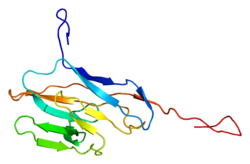CEACAM8
Appearance
| CEACAM8 | |||||||||||||||||||||||||||||||||||||||||||||||||||
|---|---|---|---|---|---|---|---|---|---|---|---|---|---|---|---|---|---|---|---|---|---|---|---|---|---|---|---|---|---|---|---|---|---|---|---|---|---|---|---|---|---|---|---|---|---|---|---|---|---|---|---|
 | |||||||||||||||||||||||||||||||||||||||||||||||||||
| |||||||||||||||||||||||||||||||||||||||||||||||||||
| Identifiers | |||||||||||||||||||||||||||||||||||||||||||||||||||
| Aliases | CEACAM8, CD66b, CD67, CGM6, NCA-95, carcinoembryonic antigen related cell adhesion molecule 8, CEA cell adhesion molecule 8 | ||||||||||||||||||||||||||||||||||||||||||||||||||
| External IDs | OMIM: 615747; HomoloGene: 68205; GeneCards: CEACAM8; OMA:CEACAM8 - orthologs | ||||||||||||||||||||||||||||||||||||||||||||||||||
| |||||||||||||||||||||||||||||||||||||||||||||||||||
| |||||||||||||||||||||||||||||||||||||||||||||||||||
| |||||||||||||||||||||||||||||||||||||||||||||||||||
| |||||||||||||||||||||||||||||||||||||||||||||||||||
| Wikidata | |||||||||||||||||||||||||||||||||||||||||||||||||||
| |||||||||||||||||||||||||||||||||||||||||||||||||||
Carcinoembryonic antigen-related cell adhesion molecule 8 (CEACAM8) also known as CD66b (Cluster of Differentiation 66b), is a member of the carcinoembryonic antigen (CEA) gene family. Its main function is cell adhesion, cell migration, and pathogen binding.[3]
Use
CEACAM8 is expressed exclusively on granulocytes and used as granulocyte marker.
See also
References
- ^ a b c GRCh38: Ensembl release 89: ENSG00000124469 – Ensembl, May 2017
- ^ "Human PubMed Reference:". National Center for Biotechnology Information, U.S. National Library of Medicine.
- ^ "Entrez Gene: CEACAM8 carcinoembryonic antigen-related cell adhesion molecule 8".
Further reading
- Khan WN, Frängsmyr L, Teglund S, et al. (1992). "Identification of three new genes and estimation of the size of the carcinoembryonic antigen family". Genomics. 14 (2): 384–90. doi:10.1016/S0888-7543(05)80230-7. PMID 1427854.
- Oikawa S, Inuzuka C, Kuroki M, et al. (1991). "A specific heterotypic cell adhesion activity between members of carcinoembryonic antigen family, W272 and NCA, is mediated by N-domains". J. Biol. Chem. 266 (13): 7995–8001. PMID 2022629.
- Berling B, Kolbinger F, Grunert F, et al. (1990). "Cloning of a carcinoembryonic antigen gene family member expressed in leukocytes of chronic myeloid leukemia patients and bone marrow". Cancer Res. 50 (20): 6534–9. PMID 2208113.
- Arakawa F, Kuroki M, Misumi Y, et al. (1990). "Characterization of a cDNA clone encoding a new species of the nonspecific cross-reacting antigen (NCA), a member of the CEA gene family". Biochem. Biophys. Res. Commun. 166 (3): 1063–71. doi:10.1016/0006-291X(90)90975-S. PMID 2306228.
- Eades-Perner AM, Thompson J, van der Putten H, Zimmermann W (1998). "Mice transgenic for the human CGM6 gene express its product, the granulocyte marker CD66b, exclusively in granulocytes". Blood. 91 (2): 663–72. doi:10.1182/blood.V91.2.663. PMID 9427723.
- Torsteinsdóttir I, Arvidson NG, Hällgren R, Håkansson L (1999). "Enhanced expression of integrins and CD66b on peripheral blood neutrophils and eosinophils in patients with rheumatoid arthritis, and the effect of glucocorticoids". Scand. J. Immunol. 50 (4): 433–9. doi:10.1046/j.1365-3083.1999.00602.x. PMID 10520185.
- Oikawa S, Sugiyama M, Kuroki M, et al. (2001). "Extracellular N-domain alone can mediate specific heterophilic adhesion between members of the carcinoembryonic antigen family, CEACAM6 and CEACAM8". Biochem. Biophys. Res. Commun. 278 (3): 564–8. doi:10.1006/bbrc.2000.3858. PMID 11095950.
- Singer BB, Scheffrahn I, Heymann R, et al. (2002). "Carcinoembryonic antigen-related cell adhesion molecule 1 expression and signaling in human, mouse, and rat leukocytes: evidence for replacement of the short cytoplasmic domain isoform by glycosylphosphatidylinositol-linked proteins in human leukocytes". J. Immunol. 168 (10): 5139–46. doi:10.4049/jimmunol.168.10.5139. PMID 11994468.
- Zhao L, Xu S, Peterson C, et al. (2002). "Purification and characterization of a 95-kDa protein--carcinoembryonic antigen-related cell adhesion molecule 8--from normal human granulocytes". J. Immunol. Methods. 270 (1): 27–35. doi:10.1016/s0022-1759(02)00215-6. PMID 12379336.
- Strausberg RL, Feingold EA, Grouse LH, et al. (2003). "Generation and initial analysis of more than 15,000 full-length human and mouse cDNA sequences". Proc. Natl. Acad. Sci. U.S.A. 99 (26): 16899–903. doi:10.1073/pnas.242603899. PMC 139241. PMID 12477932.
- Grimwood J, Gordon LA, Olsen A, et al. (2004). "The DNA sequence and biology of human chromosome 19". Nature. 428 (6982): 529–35. doi:10.1038/nature02399. PMID 15057824.
- Gerhard DS, Wagner L, Feingold EA, et al. (2004). "The status, quality, and expansion of the NIH full-length cDNA project: the Mammalian Gene Collection (MGC)". Genome Res. 14 (10B): 2121–7. doi:10.1101/gr.2596504. PMC 528928. PMID 15489334.
- Ramachandran P, Boontheung P, Xie Y, et al. (2006). "Identification of N-linked glycoproteins in human saliva by glycoprotein capture and mass spectrometry". J. Proteome Res. 5 (6): 1493–503. doi:10.1021/pr050492k. PMID 16740002.
External links
- CEACAM8+protein,+human at the U.S. National Library of Medicine Medical Subject Headings (MeSH)
- Human CEACAM8 genome location and CEACAM8 gene details page in the UCSC Genome Browser.
- PDBe-KB provides an overview of all the structure information available in the PDB for Human Carcinoembryonic antigen-related cell adhesion molecule 8 (CEACAM8)
This article incorporates text from the United States National Library of Medicine, which is in the public domain.



